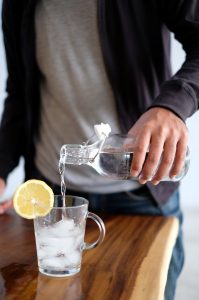Whether it is mowing the lawn, working in the garden, baling hay, or two a day’s sports practice, we spend a lot of time outdoors in the summer months. When you are outside in the heat, it is important to drink plenty of fluids to prevent dehydration. We need fluids to keep our bodies properly cooled. Without ample water, you can experience muscle cramping, heat exhaustion, or heat stroke.

How do you know how much fluid you need? Children need from 4 to 11 cups of total water (total beverages, including water) a day. Adults need from 9 to 13 cups of total water (total beverages, including water) a day. The amount depends on your age, gender, level of physical activity, altitude and climate. During hot weather, you will need more, but do not go by thirst alone. To prevent dehydration, it is important to drink plenty of water and other fluids throughout the day, even before going outdoors. One way to tell if you are drinking enough fluids is to check the color of your urine. Your urine shouldbe light yellow in color. If it is a dark color, you need to drink more water.
Be conscious about drinking enough water. Although we all know that water is essential, stress the importance of water to others around you, including children. It is a good idea to drink two cups of fluid two hours before practice or outdoor activities, to promote adequate hydration. It is also a good idea for coaches to mandate players to drink about four liters of fluid during practice; otherwise they may not drink enough. Larger volumes of fluid intake during exercise are associated with greater cardiac output, greater skin blood flow, lower core temperature, and a reduced rating of perceived exertion.
When taking in fluids, only use water or sports drinks. Avoid caffeinated, highly sweetened and carbonated beverages. These have the potential to dehydrate and contribute to nausea. Water is great for the purpose of re-hydration, but sports drinks are designed to make you want to drink more. Children will drink more sport drinks than they will water because it has more taste and contains salt, which increases their thirst.
It is important to understand the symptoms of dehydration, heat exhaustion and heat stroke. The symptoms of heat exhaustion are dizziness; cold, clammy skin; nausea and headaches. The symptoms of heat stroke are high body temperature and dry skin; confusion; and unconsciousness. People suffering from heatstroke will feel chilly and have tingling arms and goosebumps. If you feel these symptoms, get out of the heat and seek immediate medical treatment. Begin cooling down with ice baths or other means.
Please do not ignore your body in this heat. Plan for your fluid intake before you go outside. Too much exposure to the heat combined with dehydration could be fatal for you or someone you love. Be sure you take plenty of breaks and drink plenty of water
Written By Addie Wilson, County Extension Director, N.C. Cooperative Extension, Yadkin County Center